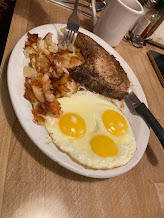Does good gluten free pizza exist?
I consider myself fortunate that I don't have Celiac Disease, or a gluten intolerance. Because I really love good pizza, and there's very little actually good gluten free pizza out there.
Diane has arthritis in her left ankle, and when she eats gluten, her ankle throbs. So sometimes that calls for eating gluten free pizza. Either in a pizzeria, or at home. Face it, I'm a saint to suffer like that.
Pizzerias often have gluten free crusts available these days, but they don't often make them. They buy them parbaked and frozen. From what I understand, there are only a few sources of wholesale to pizzeria frozen gluten free crusts. I've had a few. They're not terrible. But it would be a stretch to say they're good.
I'm a native of New Jersey, where there is no shortage of good pizza. Thus, I'm a huge pizza snob, and while I'll eat most any pizza( and not leave it over), I will complain about it as I grab another slice.
There's a pizza place in Seattle's Greenwood neighborhood that does make their own gluten free crusts, and also sells them frozen, Razzi's. People rave about them. We bought a few of their frozen crusts. Not so good. Not so good at all.
Then, A few weeks ago I saw a gluten free pizza crust kit at Grocery Outlet and tried it, and it was downright terrible. Like Godawful, so bad that even I couldn't eat it ( And I'll eat almost anything).
I've made my own gluten free pizzas a few times, with mixed results. Gluten free pizza dough barely resembles it's glutenous cousin. It's a whole different kettle of fish. What makes traditional pizza dough rise is the gluten and the yeast, so if you're using a typical gluten free flour mix, you have to add baking powder in addition to yeast, and it's just not going to develop that springiness that traditional bread and pizza doughs have. it's also going to be wetter, by necessity. It's more like a regular pie dough. It rises, but it's not really something that requires kneading( because you're not really activating things that are going to rise as a result of the yeast interacting with the gluten. The yeast is mostly for flavor.
Last week I found the Cooks Illustrated Gluten Free pizza dough recipe online. They add a little almond flour and psyllium husk to the gluten free flour mix, to aid in texture. While most gluten free recipes don't call for much time for rising, their recipe calls for a ninety minute rise time , and then a forty five minute parbake, before taking it out and topping it, and sticking it back in for another ten or fifteen minutes. It's labor intensive. Instead of stretching the dough or tossing it, you press it place into a pan.
Was it good? Well, it was the best gluten free pizza I've had. It was edible, even pretty good. But was it good? If all you ate was gluten free pizza, you'd say it was great. But I don't only eat gluten free pizza, and I won't say it was great. Maybe for what it was, it was great.
I just think gluten free pizza can't achieve greatness. I think this one achieved pretty goodness.





.jpg)
Comments
Post a Comment